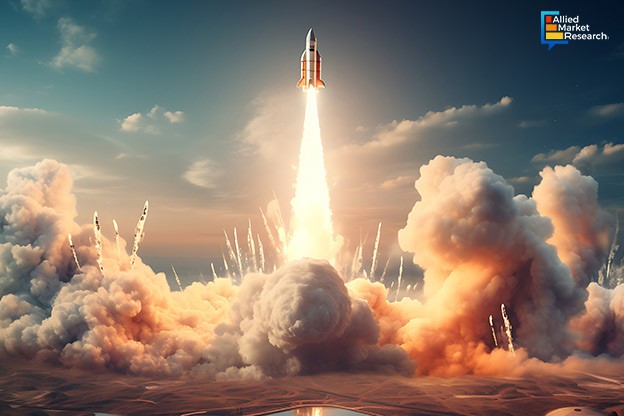Innovative Spacecraft Technologies that Are Opening New Growth Opportunities for Space Exploration Businesses

16 Apr
2024
Key takeaways:
- Introduction
- Recent advancements in the space vehicle manufacturing sector
- Rise of the domain in the Asia-Pacific region
On 20th April 2023, SpaceX conducted the first integrated flight test of its launch vehicle, Starship. With this launch, the Starship became the most powerful rocket ever flown into space. The launch vehicle has been developed by SpaceX to further its goal of colonization of Mars. While the first test flight failed to achieve its intended objectives, the second and third integrated test flights conducted on 18th November 2023 and 14th March 2024 made huge improvements. With these space launches becoming quite successful in achieving their aims, the topic of futuristic space missions once again came into the limelight.
Spacecraft technologies that are expected to play a major role in future space missions
A major reason why developed countries stopped sending manned space missions into space was the lack of sufficient government funds. Manned space missions were extremely costly and the knowledge about outer space gained from these missions, though vital, was not substantial. According to one estimate, the Apollo 11 Mission which put a man on the moon in 1969, cost around $355 million. Thus, the high risks and costs associated with manned space missions deter governments from continuing these missions.
According to space researchers and scientists, one way to reduce the costs associated with space missions is the development of reusable launch vehicles. As the name suggests, these launch vehicles do not disintegrate into flames while reentering the atmosphere; rather the vehicle is designed so that it makes a stable and successful landing. The launch vehicle, thus landed, can be once again used for future space missions, thereby saving the cost of the launch vehicle. Reusable launch vehicles and reusable spacecraft are, thus, expected to rule the roost in the spacecraft industry.
Another important trend observed in the spacecraft industry is the development of smart advanced propulsion systems. Space scientists have become successful in building a spacecraft that uses plasma engines. In this engine, the electric propulsion creates a thrust due to the generation of quasi-neutral plasma. Along with this, NASA is also testing the launch of space vehicles using nuclear fission energy. Space nuclear propulsion, as it is called, uses the energy produced from nuclear fission in place of chemical reactions that traditionally power space vehicles.
Currently, NASA is working on two types of space nuclear propulsion systems viz., thermal and electric. In nuclear thermal propulsion, the heat produced by the reactor is directly used to ignite the liquid propellant. The liquid propellant, upon receiving heat, converts into gas which further provides a thrust to the spacecraft, driving it forward. On the other hand, nuclear electric propulsion converts the heat emitted by the reactor into electricity. This electricity then charges the propellent which provides the ions to the thruster.
The role of the Asia-Pacific region in driving the industry forward
The spacecraft industry has experienced massive growth in the Asia-Pacific region, especially in India. The Indian spacecraft industry is anticipated to surge ahead at a CAGR of 8.4% in the 2023-2032 period. This growth in the Asia-Pacific region is a result of the interplay between several factors. Firstly, the governments in this region have increased their budgetary spending in the space exploration sector which is anticipated to improve the growth rate of the domain. For instance, the Government of India has increased the budgetary allocation of ISRO, India’s premier space agency.
At the same time, many new space missions are being planned by countries in this region. For example, UAE’s Hope Mars orbiter, India’s Gaganyan mission, Japan’s space mission, etc., are expected to create new opportunities for the space vehicle manufacturing industry in the coming period. The growing investments by private players in space vehicle infrastructure development projects and the rising adoption of 3D printing technologies are predicted to expand the scope of this sector.
To sum it up, innovations in space vehicle manufacturing technology are expected to help the sector register huge growth in the next few years. Advancements such as reusable launch vehicles, smart advanced propulsion systems, and space nuclear propulsion systems have augmented the growth rate of the sector.
For insights into how your business can capitalize on the opportunities offered by the industry, feel free to contact us.

Akhilesh Prabhugaonkar
Author's Bio- Akhilesh Prabhugaonkar holds a bachelor’s degree in Electronics Engineering from the reputed Vishwakarma Institute of Technology. He has a special interest in the fields of forensics, world history, international relations and foreign policy, sports, agriculture, astronomy, security, and oceanography. An ardent bibliophile and melophile, Akhilesh loves to write on topics of his interest and various other societal issues. This love for writing made him enter the professional world of content writing and pursue his career in this direction.
Avenue: Entire Library membership of Allied Market Research Reports at your disposal
- Avenue is an innovative subscription-based online report database.
- Avail an online access to the entire library of syndicated reports on more than 2,000 niche industries and company profiles on more than 12,000 firms across 11 domains.
- A cost-effective model tailored for entrepreneurs, investors, and students & researchers at universities.
- Request customizations, suggest new reports, and avail analyst support as per your requirements.
- Get an access to the library of reports at any time from any device and anywhere.
Related Post
-
Cheese Sauce: How Manufacturing Healthy and Vegan Alternatives Boosts the Potential of Brands?
-
Analyzing the Increasing Preference of Construction Companies for Artistic and Stained Glass
-
How Surface Computing Contributes to the Expansion of Multiple Industries?
-
Air Crane Helicopter: How Advanced Technology Integration Optimizes Operational Efficiency?
-
Which Latest Trends in the Cosmetics Industry Should Businesses Adopt to Stay Ahead of Their Peers?
-
How Are Bicycle Manufacturers Responding to the Evolution in the Gear Bicycle Industry?
-
How Investment in Green Hydrogen Technology Is a Profitable Business Decision?








